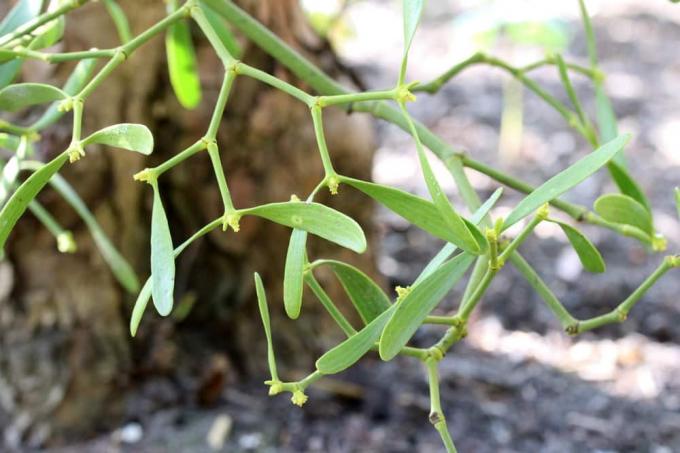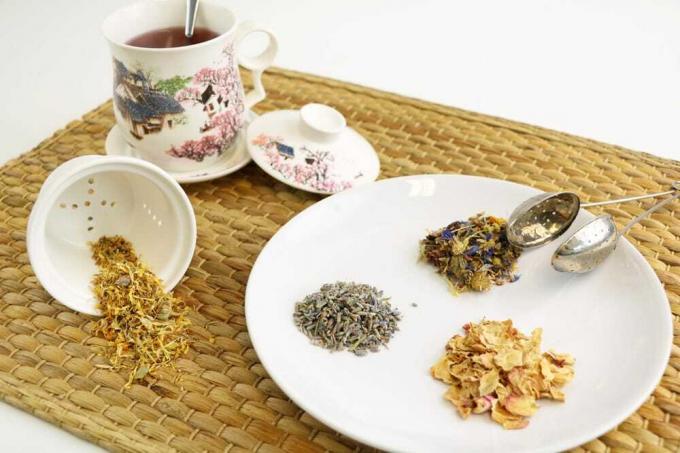

Table of contents
- Recognize
- Collect
- dry
- Properties & healing effects
- prepare tea
Mistletoe has long been used in the preparation of healing teas and tinctures. Since these grow wild between the trees in the local latitudes, the plants can be collected and prepared with the appropriate prior knowledge. However, the medicinal plant also has toxic properties, so caution is advised when making mistletoe tea. In addition, certain aspects must be observed during drying so that this process works well.
Recognize
Mistletoe is an evergreen plant that grows as a parasite in the crowns of deciduous and coniferous trees. However, mistletoe is only a semi-parasite, since the plants carry out photosynthesis on their own and only use the water of the host for their own purposes. In addition, the mistletoe does not destroy its host trees, it just makes itself at home there. Due to the height of many trees, this plant is not easy to find. Mistletoe is best spotted in autumn when the leaves have already fallen from the trees. Then the mistletoe can be tracked down in the form of a rounded nest in the treetops. Under no circumstances should entire branches be sawn off in order to get to the hidden nests, this rough behavior is frowned upon for ecological reasons.
- Lives on top of trees, especially in fruit trees and poplars
- Mistletoe grows about a meter tall and wide
- Mistletoe develops yellowish-green leaves
- The light green branches form a ball
- Flowers are also yellowish-green, relatively inconspicuous and smell slightly of orange
- Flowering time is from March to April
- From autumn, waxy and whitish berries develop
- Berries fully ripen in December
Collect

Mistletoe can be collected in the local areas without any problems, since these are not subject to legal nature protection. However, picking is only permitted for private purposes. If you want to collect medicinal plants on a larger scale for commercial purposes, you need official approval beforehand. To protect the plant and its host tree, a careful approach is very important. The aroma of medicinal herbs is weakest on rainy days and in the evening and night hours, so these times should be avoided for harvesting. Since mistletoe berries are highly poisonous, the leaves and twigs should not be collected while they are ripe. Otherwise, if you accidentally prepare the mistletoe tea with the berries it contains, symptoms of poisoning can occur.
- Mistletoe grows very slowly and can get very old
- Therefore only pick in small quantities
- Just take a few branches at a time and the plant will grow back
- Never damage the host tree
- A sharp ceramic knife is ideal for cutting
- Place in a soft cloth for transport
- Only the young branches with leaves are used in natural medicine
- The optimal period for collecting is between autumn and spring
- Best harvested in March and April
- Ideally pick in the early hours of the morning to late in the morning
- If possible do not wash
- Remove heavy soiling with a kitchen towel
- Dry the branches gently and only then cut them
Tip:
It is best to collect the medicinal herbs on a rain-free morning if they have seen a lot of sunlight for at least one or better two days before the harvest day.
dry
So that the leaves do not fall off the dried mistletoe, this medicinal plant needs gentle drying. If the plants are brought directly into warm living rooms, the leaves and branches will dry up very quickly and then fall off. The reason for this is that the pathways in the stems die off too quickly. If the leaves suddenly stop getting water, they will dry up. This is followed by a yellow and then a brown discoloration, after which the leaves simply fall off. During the gentle drying process, the parts of the plant gradually lose the water reserves they contain.
- Dry in the fresh air for a few days after cutting
- Hang cut mistletoe upside down outside
- Tie into a bouquet beforehand
- Protect dried bouquets from moisture and rain
- Covered terraces and balconies are ideal for drying
- Then bring it into the house and store it away from moisture
Properties & healing effects

Mistletoe has been used as a medicinal plant in folk medicine for thousands of years and is considered a panacea. Today, their healing effects have been scientifically proven and documented by many healing successes. The mistletoe contains many pharmaceutically active ingredients, including alkaloids, asparagine, bitter substances, resins, histamine, lecithin and viscotoxins. In addition, mistletoe contains minerals and secondary plant substances, including flavonoids, which have antioxidant properties.
- Regulates blood pressure and reduces dizziness
- Helps with arteriosclerosis and tinnitus
- Reduces the symptoms of epilepsy
- Relieves asthma, hay fever and whooping cough
- Helps with feelings of anxiety and nervousness
- Improves mental and physical states of exhaustion
- Strengthens the immune system, helpful in diabetes
- Alleviates symptoms of respiratory diseases
- Stimulates the metabolism
- Helps with menstrual problems and menstrual pain
- Reduces discomfort during menopause
prepare tea
In order to enjoy the healing properties of mistletoe, they are usually prepared as a tea. After the mistletoe herb has dried sufficiently, it is ready for preparation. However, mistletoe has slightly toxic ingredients, which is why this medicinal plant must not be boiled. Otherwise, the toxins contained in it will dissolve in the hot water. In addition, heating the mistletoe reduces its healing properties. If you want to drink mistletoe tea regularly for health reasons, you should discuss this with your family doctor. Like any other medicinal plant, mistletoe can cause various side effects that can have a negative effect on existing health problems. Some people can also have an allergic reaction to the ingredients in mistletoe, so caution is advised in this case.
- Always prepare mistletoe tea cold
- Carefully chop or trim mistletoe
- Add 1-2 teaspoons of dried mistletoe to 250ml of cold water
- Leave the mixture cold overnight, about 12 hours
- Then strain well, there shouldn't be any leftovers
- Warm up slightly before enjoying
- The broth must not boil
- Drink 1-2 cups of mistletoe tea every day
- Mistletoe tea infusions mix well with other types of tea
- These include marjoram, marigold, horsetail, and willow bark
 garden editorial
garden editorial I write about everything that interests me in my garden.
Learn more about tea

Collect and dry herbs for tea yourself
A herbal tea is not only inexpensive and low in calories, but also very healthy and tasty. Given the variety of herbs and herbal mixtures, everyone should be able to find their favorite tea. Collecting and drying yourself is a great alternative to the mixtures in the supermarket.

20 tea herbs | Grow herbs for tea yourself
Tea is the most popular beverage on earth and is enjoyed in numerous cultures for culinary and medicinal reasons. In addition to the real tea plant, there are numerous tea herbs that you can grow yourself in the garden, on the balcony or on the windowsill.

Collect lady's mantle: make lady's mantle tea yourself | Instructions
Lady's mantle is not uncommon in this country. Where this plant has taken root, it grows luxuriantly. With this great offer you should take bold action. Simply harvest and dry some beautifully shaped leaves. Lady's mantle tea tastes good and is also healing.

Make & produce herbal tea yourself
You can easily make a herbal tea yourself and collect the necessary medicinal herbs in many places in the surrounding nature. After drying, the various healing plants can be mixed as desired and required and enjoyed pure or sweetened as a hot drink.

Raspberry Leaf Tea: Drying and preparing raspberry leaves for tea
Raspberry leaf tea tastes slightly fruity, like the berries of the bush, but at the same time like an exotic herbal tea. It is also used in herbal medicine. If you want to dry and prepare raspberry leaves for tea, you will find the right instructions here.

Jiaogulan tea - all about preparation, effects and side effects
The medicinal herb Jiaogulan, which originated in Japan and China, is also known as the "herb of immortality". Its effect is said to be similar to that of ginseng. The leaves can be dried or used fresh and, above all, brewed as a tea and are said to help against aging.



